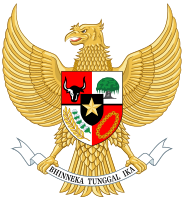Second Development Cabinet
| Second Development Cabinet Kabinet Pembangunan II | |
|---|---|
29th Cabinet of Indonesia | |
| Indonesian Government (Executive Branch) | |
 | |
| Date formed | 28 March 1973 |
| Date dissolved | 29 March 1978 |
| People and organisations | |
| Head of state | Suharto |
| Member party | Golkar, Indonesian National Armed Forces, Indonesian Democratic Party and United Development Party |
| Status in legislature | Coalition |
| History | |
| Predecessor | First Development Cabinet |
| Successor | Third Development Cabinet |
The Second Development Cabinet (Indonesian: Kabinet Pembangunan II) was the Indonesian Cabinet which served under President Suharto and Vice President Hamengkubuwono IX. The Cabinet was formed after Suharto was elected to a 2nd term as President by the People's Consultative Assembly (MPR). It has the distinction as the last Cabinet which contains members of the United Development Party (PPP) and the Indonesian Democratic Party (PDI).[1] After this Cabinet and until Suharto's fall in 1998, all the other Development Cabinets would be dominated by members of Golkar and ABRI.
The Six Cabinet Aims[]
- Preserving and strengthening political stability.
- Preserving and strengthening economic stability.
- Preserving and strengthening security and order.
- Completing the First Government Five Year Plan and executing the Second Government Five Year Plan as per the Broad Outlines of State Policy.
- Strengthening the People's Welfare.
- Strengthening order within the State Apparatus Utilization.
President and Vice President[]
- President: Gen. Suharto
- Vice President: Sri Sultan Hamengkubuwana IX
Departmental Ministers[]
- Minister of Home Affairs: Lt. Gen. Amirmachmud
- Minister of Foreign Affairs: Adam Malik
- Minister of Defense and Security/Commander of ABRI: Gen. Maraden Panggabean
- Minister of Justice: Umar Seno Aji
- Minister of Information: Mashuri
- Minister of Finance: Ali Wardhana
- Minister of Trade: Radius Prawiro
- Minister of Agriculture: Thoyib Hadiwidjaya
- Minister of Industry: Lt. Gen. M Jusuf
- Minister of Mines: Mohammad Sadli
- Minister of Public Works and Electricity: Sutami
- Minister of Transportation: Emil Salim
- Minister of Education and Culture: Sumantri Brodjonegoro
- Minister of Health: G. A. Siwabessy
- Minister of Social Affairs: H. M. S. Mintaredja
- Minister of Manpower, Transmigration, and Cooperatives: Subroto
- Minister of Religious Affairs: Mukti Ali
State Ministers[]
- State Minister of People's Welfare: Sunawar Sukowati
- State Minister of Economics and Finance/Chairman of the National Development Planning Body (BAPPENAS): Widjojo Nitisastro
- State Minister of State Apparatus Control/Vice Chairman of BAPPENAS: J. B. Sumarlin
- State Minister of Research: Sumitro Djojohadikusumo
- State Minister/State Secretary: Maj. Gen. Sudharmono
Official With Ministerial Rank[]
- Attorney General: Ali Said
- Governor of Central Bank: Rachmat Saleh
- Commander of the Operational Command for the Restoration of Security and Order (KOPKAMTIB)/Deputy Commander of ABRI: Gen. Sumitro
Changes[]
- 1974: Umar Seno Adji was appointed Chief Justice of the Supreme Court. He was replaced as Minister of Justice by Mochtar Kusumaatmadja.
- January 1974: Sumitro resigned the Commandership of KOPKAMTIB after the Malari Incident and was replaced by President Suharto.
- March 1974: Sumitro was replaced as Deputy Commander of ABRI by General Surono.
- October 1977: Adam Malik resigned from the Cabinet to become Chairman of MPR/Speaker of the People's Representative Council (DPR). He was replaced as Minister of Foreign affairs by Mochtar Kusumaatmaja.
References[]
- Simanjuntak, P. N. H. (2003), Kabinet-Kabinet Republik Indonesia: Dari Awal Kemerdekaan Sampai Reformasi (in Indonesian), Jakarta: Djambatan, pp. 332–344, ISBN 979-428-499-8.
Notes[]
- ^ Bongkar Pasang dari Kabinet ke Kabinet Archived 2007-09-27 at the Wayback Machine
Categories:
- New Order (Indonesia)
- Cabinets of Indonesia
- Suharto
